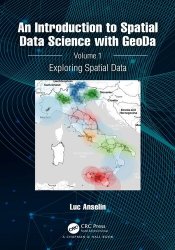 Название: An Introduction to Spatial Data Science with GeoDa, Volume 1: Exploring Spatial Data
Название: An Introduction to Spatial Data Science with GeoDa, Volume 1: Exploring Spatial DataАвтор: Luc Anselin
Издательство: CRC Press
Год: 2024
Страниц: 453
Язык: английский
Формат: pdf (true)
Размер: 20.4 MB
This book is the first in a two-volume series that introduces the field of Spatial Data Science. It offers an accessible overview of the methodology of exploratory spatial data analysis. It also constitutes the definitive user’s guide for the widely adopted GeoDa open-source software for spatial analysis. Leveraging a large number of real-world empirical illustrations, readers will gain an understanding of the main concepts and techniques, using dynamic graphics for thematic mapping, statistical graphing, and, most centrally, the analysis of spatial autocorrelation. Key to this analysis is the concept of local indicators of spatial association, pioneered by the author and recently extended to the analysis of multivariate data.
The focus of the book is on intuitive methods to discover interesting patterns in spatial data. It offers a progression from basic data manipulation through description and exploration to the identification of clusters and outliers by means of local spatial autocorrelation analysis. A distinctive approach is to spatialize intrinsically non-spatial methods by means of linking and brushing with a range of map representations, including several that are unique to the GeoDa software. The book also represents the most in-depth treatment of local spatial autocorrelation and its visualization and interpretation by means of GeoDa.
The coverage in this chapter is aimed at novices who are not very familiar with spatial data manipulations. Most of the features illustrated can be readily accomplished by means of dedicated GIS software or by exploiting the spatial data functionality available in the R and Python worlds. Readers knowledgeable in such operations may want to just skim the materials in order to become familiar with the way they are implemented in GeoDa. Alternatively, these operations can be performed outside GeoDa, with the end result loaded as a spatial data layer.
The libgeoda library has a clearly defined Application Programming Interface (API), which allows other C++ code to access its functionality directly. In fact, this is what currently happens under the hood for part of desktop GeoDa, and in the experimental web-GeoDa (jsgeoda, implemented through jаvascript). In addition to achieving a more flexible interaction with different graphical user interface implementations, the API also allows other software, such as R or Python programs to access the functionality through well-defined wrapper code.
The primary focus in this effort so far has been to create an R package, rgeoda, and a Python module, pygeoda. These provide easy access to the functionality in libgeoda through a native interface and designated middleware. The interaction between R and Python and the C++ library is implemented under the hood, so that from a user’s perspective, everything works natively as in any other R package or Python module.
The book is intended for readers interested in going beyond simple mapping of geographical data to gain insight into interesting patterns. Some basic familiarity with statistical concepts is assumed, but no previous knowledge of GIS or mapping is required.
Key Features:
• Includes spatial perspectives on cluster analysis
• Focuses on exploring spatial data
• Supplemented by extensive support with sample data sets and examples on the GeoDaCenter website
This book is both useful as a reference for the software and as a text for students and researchers of Spatial Data Science.
Скачать An Introduction to Spatial Data Science with GeoDa, Volume 1: Exploring Spatial Data